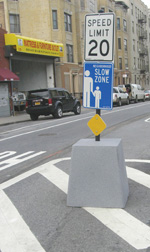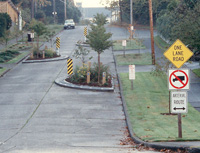Live long enough in a densely populated part of the city like Park Slope and you’re bound to become frustrated with some aspect of traffic. Whether it is cars speeding or doing U-turns, bicyclists running through red lights or traveling on sidewalks, or pedestrians not looking both ways before they cross a street (a good idea even on a one-way street), the use of our streets seems not just chaotic but anarchic.
On Saturday, Jan. 21, more than 75 people came to a meeting, organized by the Park Slope Civic Council, to learn about a New York City Department of Transportation (NYCDOT) initiative called neighborhood slow zones. These zones, as described on NYCDOT website, “are a community-based program that reduces the speed limit from 30 mph to 20 mph and adds safety measures within a select area in order to change driver behavior. The ultimate goal of the Neighborhood Slow Zone program is to lower the incidence and severity of crashes. Slow Zones also seek to enhance quality of life by reducing cut-through traffic and traffic noise in residential neighborhoods.”

For some time, the Civic Council has been involved with livable-streets initiatives; indeed, the mission statement of the Civic Council’s Livable Streets Committee focuses on “the richness of [Park Slope’s] street life.” To help fulfill that mission and learn more about traffic calming in another community, in October a group of Civic Council members went to Hoboken, N.J., where a 20-mph residential speed limit is in place. At the same time, NYCDOT was putting a pilot neighborhood slow zone into the Claremont neighborhood in the central Bronx. With the experience of the Hoboken visit, the Civic Council decided to organize a community meeting about slow zones.
A week before our January meeting, several Civic Council members and others went to Claremont to see the pilot project first-hand. This “boots-on-the-ground” look at the community and at the measures NYCDOT put into place to mark entrances to the zone, and the streets within it, was very informative.
Claremont is a mostly residential, low- to moderate-income community just south of the Cross Bronx Expressway and just west of the Bronx River. A ridge runs roughly northeast to southwest through the middle of the neighborhood, giving it a hilly character. The pilot slow zone is bounded on three sides by commercial streets, and most of the streets within the zone are one-way, approximately the same width as Park Slope’s streets. NYCDOT has marked the entrances to the slow zone with pavement striping and signs. Within the zone, “20 mph” is painted in the travel lane, and speed humps have been installed in several places.
After seeing images of the Claremont project in a presentation at the community meeting, participants were asked whether these measures gave a different sense of place — in other words, a feeling that the reduced speed limit made the streets safer to use by pedestrians, cyclists, and motorists. Considering that the field trip to the Bronx took place on a cold Saturday with few people or cars out, it was difficult to ascertain. Several people at the meeting expressed dissatisfaction with the physical elements of the Claremont neighborhood slow zone, including speed humps, excessive signage, ugly pavement striping, and loss of parking.
Many attendees cited the lack of enforcement of existing traffic laws as a major factor contributing to unsafe conditions on our local streets. A show of hands requested by one of the participants, however, showed that nearly everybody at the meeting supported a reduced residential speed limit.
Surveys prepared by the Civic Council were handed out at the meeting to investigate opinions further. Forty-nine people filled them out. Results will be included in a meeting report to be posted on our website (www.parkslopeciviccouncil.org/slow-zones) along with an audio file of the meeting and a proposal for a Park Slope neighborhood slow zone. We eagerly solicit comments from the community on these documents.
The Prospect Heights Neighborhood Development Council, a meeting co-sponsor that worked with the Civic Council to organize and publicize the event, has put a proposal for a Prospect Heights slow zone on its website, www.phndc.org.
So where do we go from here? First, NYCDOT will entertain slow-zone applications from civic associations, business improvement districts, local community boards, and elected officials, with a stated deadline of Feb. 3. NYCDOT has indicated that a proposed neighborhood slow zone should be approximately a quarter square-mile (around five blocks by five blocks); be primarily residential; avoid wide, major streets, and industrial and major commercial areas within the zone; and have strong boundaries, such as highways, large parks, elevated trains, dead ends, and major streets. NYCDOT will not implement every slow-zone application, nor will they will not set up any zone without approval from the local community board.

Second, while the people at the meeting wanted a lower residential speed limit, it was clear that there had to be a much larger “toolbox” of traffic-calming measures than those used in Claremont, which were put in quickly and at low cost. Some participants wanted speed humps; others did not. Midblock chicanes or “neckdowns” might be installed where there are fire hydrants or other existing no-parking zones, which would force traffic to slow down. In many places there are too many traffic signs; elsewhere, not enough. Other measures are also available, many of which appear in a Traffic Calming Primer developed for the Downtown Brooklyn Traffic Calming Project (downloadable here).
Of course, every physical measure has advantages and disadvantages that need to be weighed, and some basic education is needed. For example, many drivers are unaware that the city speed limit is 30 mph. And the need for consistent and visible enforcement cannot be denied. The Civic Council has long had an excellent relationship with the Police Department’s 78th Precinct, and we are sensitive to the fact that their resources are limited. This might well be the time to urge our elected representatives to increase the size of the Police Department to allow for more enforcement.
Whatever form further traffic calming takes in our community, the Civic Council will remain actively involved in promoting it, to ensure that our community’s streets are safe for all users.
The Park Slope Civic Council thanks the meeting co-sponsors for their support: City Councilmembers Letitia James, Brad Lander, and Stephen Levin; Congregation Beth Elohim; P.S. 10; Park Slope Neighbors; Park Slope Parents; the Parents Association of Brooklyn Millennium High School; and the Prospect Heights Neighborhood Development Council. We also wish to thank the organizations that helped publicize the Jan. 21 meeting: Brooklyn Spoke, P.S. 39, P.S. 321, the Park Slope Fifth Avenue Business Improvement District, Streetsblog, and Transportation Alternatives.
— Michael Cairl is president of the Civic Council.

Next: A report from our community meeting
Learn more about slow zones and traffic calming:
- Civic Council website’s page on slow zones
- NYCDOT Neighborhood Slow Zones Pilot Study
- The New York City Pedestrian Safety Study & Action Plan
- The NYC Street Design Manual
- Downtown Brooklyn Traffic Calming Primer
from the Winter 2012 Civic News

